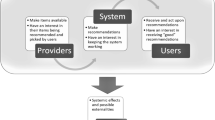Abstract
Imagine a system that gives you satisfying recommendations when you want to rent a movie with friends or find a restaurant to celebrate a colleague’s farewell: at the core of such a system is what we call group recommendation. While computing individual recommendations have received lots of attention (e.g., Netflix prize), group recommendation has been confined to studying users’ satisfaction with different aggregation strategies. In this paper (Some results are published in an earlier conference paper (Amer-Yahia et al. in VLDB, 2009). See Sect. “Paper contributions and outline” for details.), we describe the challenges and desiderata of group recommendation and formalize different group consensus semantics that account for both an item’s predicted ratings to the group members and the disagreements among them. We focus on the design and implementation of efficient group recommendation algorithms that intelligently prune and merge per-user predicted rating lists and pairwise disagreement lists of items. We further explore the impact of space constraints on maintaining per-user and pairwise item lists and develop two complementary solutions that leverage shared user behavior to maintain the efficiency of our recommendation algorithms within a space budget. The first solution, behavior factoring, factors out user agreements from disagreement lists, while the second solution, partial materialization, selectively materializes a subset of disagreement lists. Finally, we demonstrate the usefulness of our group recommendations and the efficiency and scalability of our algorithms using an extensive set of experiments on the 10 M ratings MovieLens data set.
Similar content being viewed by others
References
Adomavicius G., Tuzhilin A.: Toward the next generation of recommender systems: A survey of the state-of-the-art and possible extensions. IEEE Trans. Knowl. Data Eng. 17(6), 734–749 (2005)
Amer-Yahia, S., Benedikt, M., Lakshmanan, L., Stoyanovich, J.: Efficient network-aware search in collaborative tagging sites. In: VLDB (2008)
Amer-Yahia, S., Roy, S.B., Chawla, A., Das, G., Yu, C.: Group recommendation: Semantics and efficiency. In: VLDB (2009)
Baatarjav E.-A., Phithakkitnukoon S., Dantu R.: Group recommendation system for facebook. In: Meersman, R., Tari, Z., Herrero, P. (eds) OTM Workshops, vol. 5333 of Lecture Notes in Computer Science., pp. 211–219. Springer, Berlin (2008)
Carey, M.J., Kossmann, D.: On saying “enough already!” in sql. In: SIGMOD (1997)
Chen Y.-L., Cheng L.-C., Chuang C.-N.: A group recommendation system with consideration of interactions among group members. Expert Syst. Appl. 34(3), 2082–2090 (2008)
Fagin R.: Combining fuzzy information: An overview. SIGMOD Rec. 32(2), 109–118 (2002)
Fagin, R. et al.: Optimal aggregation algorithms for middleware. In: PODS (2001)
Garey M.R., Johnson D.S.: Computers and Intractability: A Guide to the Theory of NP-Completeness. W.H. Freeman and Company, San Francisco (1979)
GroupLens at University of Minnesota. http://www.grouplens.org/node/73
Jameson, A., Smyth, B.: The Adaptive Web, vol. 4321 of LNCS, Chapter Recommendation to Groups, p. 596. Springer, Berlin (2007)
Jarvelin K., Kekalainen K.: Cumulated gain-based evaluation of ir techniques. ACM TOIS 20(4), 422–446 (2002)
Kim, H.O.J.K., Kim, H.K., Ryu, Y.: A group recommendation system for online communities. Int. J. Inf. Manage. (2009)
Konstan, J.A.: Introduction to recommender systems. In: SIGIR (2007)
Marian, A., Amer-Yahia, S., Koudas, N., Srivastava, D.: Adaptive processing of top-k queries in xml. In: ICDE (2005)
Martello S., Toth P.: Knapsack Problems: Algorithms and Computer Implementations (Wiley-Interscience Series in Discrete Mathematics and Optimization). Wiley, London (1990)
McCarthy K., McGinty L., Smyth B.: Case-based group recommendation: Compromising for success. In: Weber, R., Richter, M.M. (eds) ICCBR, vol. 4626 of Lecture Notes in Computer Science, pp. 299–313. Springer, Berlin (2007)
O’Connor, M., Cosley, D., Konstan, J.A., Riedl, J.: Polylens: A Recommender System for Groups of User. In: ECSCW, pp. 199–218. (2001)
Park M.-H., Park H.-S., Cho S.-B.: Restaurant recommendation for group of people in mobile environments using probabilistic multi-criteria decision making. In: Lee, S., Choo, H., Ha, S., Shin, I.C. (eds) APCHI, vol 5068 of Lecture Notes in Computer Science, pp. 114–122. Springer, Berlin (2008)
Sahni, S.: Approximate algorithms for the 01 knapsack problem. In: Journal of the ACM. ACM (1975)
Author information
Authors and Affiliations
Corresponding author
Rights and permissions
About this article
Cite this article
Basu Roy, S., Amer-Yahia, S., Chawla, A. et al. Space efficiency in group recommendation. The VLDB Journal 19, 877–900 (2010). https://doi.org/10.1007/s00778-010-0209-3
Received:
Revised:
Accepted:
Published:
Issue Date:
DOI: https://doi.org/10.1007/s00778-010-0209-3




